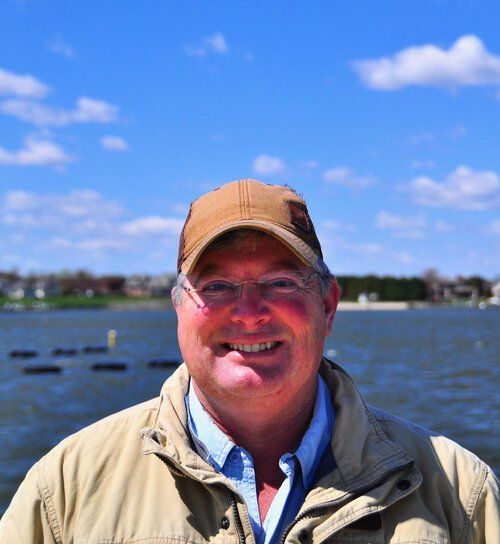Tradition and Innovation — Oyster Aquaculture in the Bay
Now, in the 21st Century, the Maryland oyster industry has entered a new phase with the development of aquaculture — raising oysters in underwater “farms” instead of harvesting them in the wild. Among the pioneers of this new way of supplying oysters is Scott Budden of Kent County, whose Orchard Point Oyster Co. farm off Eastern Neck Island has been putting Chester River oysters on diner’s plates since 2016. Common Sense interviewed Budden by phone on Dec. 30.
After attending Kent County High School, Budden graduated from Bucknell University in 2007, with a double major in Economics and International Relations. But after working in corporate jobs in the Washington D.C. area, including a two-year stint as business analyst for The Atlantic magazine, Budden read about new Maryland legislation allowing oyster aquaculture. “It really just hooked me,” he said. He saw it as a way not only to get out of the office, but to help the environment and the economy of his home county.
So, after exploring the subject with other Chesapeake oyster farmers, he applied for a lease to start his own farm in 2012. That began a long journey through the state’s bureaucracy, but with some support of the Kent County commissioners, he completed the process and planted his first crop in 2015. Quitting his main job, he moved in with his parents, local realtors Richard and Vicki Budden of Chestertown, for a while. He spent the initial year working two additional part-time jobs while getting the farm started.
The hard work paid off. The first year, he planted 330,000 oysters on the initial five-acre plot. The next year he doubled his crop, and his output continued to grow. Farm manager Sean Corcoran came on board in 2017, and the following year he joined with two partners, Hal McBee Jr. and Brian Connelly. The company currently has three full-time employees and one part-timer, with another full-time worker for the summer.
Photos: Jay Flemming, Scott Budden
They get their seed stock from private hatcheries in Maryland and Virginia. After the addition of new acreage in the Eastern Bay off Kent Island, Orchard Point Oyster Co. planted five million oysters in the water in 2019. In 2020, they scaled back to 3.5 million because of covid-19, but at the same time began to explore new ways to market the product — including the company’s online “Shuck Shop™,” providing mail-order delivery to oyster-lovers in New York state, Florida, and the west coast. They’ve also started a new brand, “Orchard Point Primes (OPP),” a larger version of the company’s regular oysters (Classics).
Since the pandemic began, direct retail sales have expanded to almost 80 percent of their business. But they still deliver to wholesalers all over the area — Scott often driving the van himself. Other days, he’s out on the water or in the office handling sales and marketing.
The regulatory hurdles for new aquaculture businesses are still formidable, Budden said. “It still takes quite a while to get a lease issued.” He said that other states, such as Virginia, can process applications more efficiently because their governments have dedicated marine divisions whereas Maryland’s Department of Natural Resources has to provide a wider range of services. There are a lot of applications in the queue, and the pandemic has created more delays than usual.
Budden’s and the company’s success is just one sign that oyster aquaculture is thriving. Starting with only five acres underwater, he and his partners now work almost 23 acres in two major tributaries in three counties. “The business has grown quite a bit, both in Maryland and nationally,” Budden said. He estimated there are 150 oyster farms statewide, harvesting from about 6,500 acres. That means more competition, more brands on the market, and more choices for consumers. “It’s a buyer’s market now,” he said. Budden expects prices to remain stable, especially after restaurants reopen in the wake of the pandemic. That will put more money in farmers’ pockets as well as giving the public more opportunity to enjoy oysters. There are even online courses in shucking oysters from a national company. Budden said that learning how to shuck was one of the fun things he had picked up after starting the business — “it’s a great party trick,” he said, but it also gives a real sense of accomplishment when done well.
Oyster lovers can place orders through the website — https://www.orchardpointoysters.com/shop — for delivery locally, for pickup at the Retriever Bar & Decoy Bottle Shop in Chestertown or the farm office in Stevensville, and for cold-shipping by overnight express. They’re available shucked or in the shell, as few as a dozen or in party-size lots. It’s a great way to tickle your taste buds while supporting a locally owned business.
Peter Heck is a Chestertown-based writer and editor, who spent 10 years at the Kent County News and three more with the Chestertown Spy. He is the author of 10 novels and co-author of four plays, a book reviewer for Asimov’s and Kirkus Reviews, and an incorrigible guitarist.
Common Sense for the Eastern Shore














